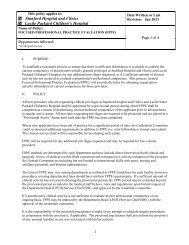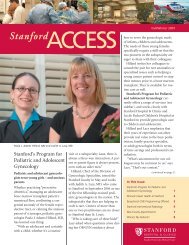rEdEFInIng - Stanford Hospital & Clinics
rEdEFInIng - Stanford Hospital & Clinics
rEdEFInIng - Stanford Hospital & Clinics
You also want an ePaper? Increase the reach of your titles
YUMPU automatically turns print PDFs into web optimized ePapers that Google loves.
oNCoLoGY<br />
STANfoRd WomEN’S CANCER CENTER<br />
In the summer of 2011, the <strong>Stanford</strong> Women’s Cancer Center will open<br />
its doors. The Center will considerably enlarge the current clinical space<br />
dedicated to the treatment of women with breast and gynecologic cancers,<br />
providing individualized and compassionate care for the whole patient.<br />
The Women’s Cancer Center will begin each woman’s journey toward<br />
survivorship with concierge services to help her navigate and manage her<br />
treatment. Support groups for patients and family members will be part of<br />
a care package that includes counseling, palliative care, survivorship<br />
services and more. In an atmosphere with warmth and welcome at its core,<br />
founded upon the advanced clinical trials and ground-breaking translational<br />
research for which <strong>Stanford</strong> is known, the Women’s Cancer Center programs<br />
will feature an integrative healing approach to strengthen the body, educate<br />
the mind and nurture the spirit.<br />
2<br />
better<br />
JuST STEPS FROM THE STANFORD CANCER<br />
CENTER, THE NEW STANFORD WOMEN’S CANCER<br />
CENTER WIll PROVIDE RESOuRCES, SuPPORT<br />
AND ExPERTISE TO WOMEN WITH BREAST AND<br />
gYNECOlOgIC CANCERS.<br />
Return to TOC<br />
options FOr mOrE PATIEnTs<br />
“Thanks to innovations and new treatment<br />
methods, we can really offer a more positive<br />
experience to nearly every person we treat.”<br />
Dr. Frederick Dirbas<br />
Breast Cancer Surgeon<br />
With no family history of cancer, Polly Weinheimer was<br />
surprised when, after a routine check-up in 2002, her<br />
doctor advised her to contact <strong>Stanford</strong> cancer surgeon<br />
Dr. Frederick Dirbas for a breast cancer consultation.<br />
“Many patients fear the worst when they receive a cancer<br />
diagnosis,” says Dr. Dirbas. “But thanks to innovations and<br />
new treatment methods, we can really offer a more positive<br />
message and experience to nearly every person we treat.”<br />
Cancer therapies that were once brutally invasive have<br />
evolved. Depending on the size and location of a tumor,<br />
lumpectomies, improved chemotherapy and more targeted<br />
radiation have all eased the treatment burden for patients.<br />
Dr. Dirbas told Polly she was a prime candidate for<br />
intraoperative radiation therapy (IORT), a new protocol<br />
to treat the size of tumor she had. When her tumor was<br />
removed, radiation treatment was sent directly into the<br />
tissue surrounding the tumor at the time of the surgery.<br />
The single treatment replaced six weeks of daily radiation<br />
after surgery. Dr. Dirbas was one of just a handful of<br />
physicians, and <strong>Stanford</strong> <strong>Hospital</strong> one of a similarly<br />
small group of hospitals, to offer IORT for breast cancer<br />
at that time.<br />
Instead of enduring the exhaustion and discomfort that are<br />
common side effects of multiple radiation sessions, Polly<br />
went home and got back to her life. Today, nearly a decade<br />
after her treatment, she is 70 years old and still enjoying her<br />
favorite hiking trails.<br />
3
















